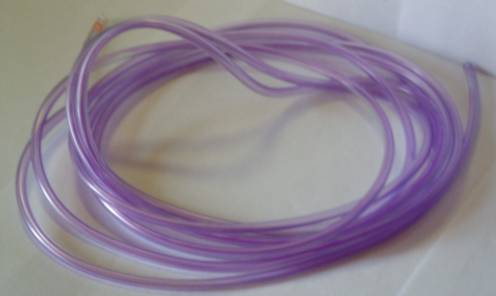
Examples of Coating Development
Cetry helps medical device manufacturers and their suppliers by means of problem solving, process modelling, characterization of product properties, device and materials qualification, process and manufacturing validation, related regulatory issues, quality assurance, and design and build of specialized equipment. Here follow some examples of coating development for medical devices, done by or assisted by Cetry.

List of Examples:
Related Pages:
EMPEH low friction anti-thrombogenic coatingIoHep heparin coating
CovHep heparin coating
Low friction anti-thrombogenic coating
| • Client: | Cetry - in-house development |
| • Subject: | Low friction anti-thrombogenic coating |
A coating was developed, in house, with the aim of making PVC tubing anti-thrombogenic. The problem with flexible PVC is that it "sweats" low molecular components (softeners) to the surface. These components are harmless from a biocompatibility point of view, but they obstruct adhesion of coatings. The anti-thrombogenic coating thus had to be designed to deal with these components in order to still obtain good adhesion on the one hand and sustained anti-thrombogenicity on the other. The result is the EMPEH coating (see PRODUCTS). The photograph at the top of this page shows PVC tubing (4 meters) that was coated on the inside with the heparin-based EMPEH coating. The coating itself is colorless and transparent, but staining with toluidine-blue O reveals the presence of the heparin (the violet color). The photograph depicts the toluidine-stained coating. Characterization of this coating revealed that it also showed very low friction, both dry and wet, when tested against metals and polymers. The coefficient of friction was slightly less (i.e. better) than that of high-density polyethylene (HDPE) under similar conditions, and it was often equal to that of PTFE. The big difference with PTFE and PE is found in its clinical application. HDPE and PTFE are not anti-thrombogenic and will eventually give rise to clotting-induced increase of friction. The EMPEH coating does not, because it prevents clotting. The friction properties were also examined and confirmed by an independent party. The coating can be applied to, e.g., PVC (as mentioned), polyethylenes, nylons, linear polyurethanes, and even some silicones.
return to top...
Ionically bound heparin coating
| • Client: | Cetry - in-house development |
| • Subject: | Ionically bound heparin coating |
This coating was developed in order to allow low-budget application to high-volume medical devices, such as diagnostic catheters. The aim was to prevent coagulation of blood during the clinical procedure. Device-induced coagulation may give rise to thrombus-related negative events such as small artery blockage. In-vivo tests proved that the heparin coating remains fully active in the blood for at least several hours, which is generally much longer than the clinical procudere will take. The coating is especially useful inside the catheters, since that is where the blood often stands still and "sees" lots of surface. The latter results in fast and lots of contact-activated coagulation. The coating is extremely thin, and will thus not compromise dimensions of existing (catheter-)designs. It can be applied to nylon, linear polyurethanes, polyethylenes, etc. Methods have been developed for application to low-sweating silicones. This coating is called IoHep, and more information can be found under PRODUCTS.
return to top...
Covalent heparin coating
| • Client: | Cetry - in-house development |
| • Subject: | Covalent heparin coating |
This coating is based on covalently-bound heparin. Development of a water-based reactive solution that still leads to covalent binding of the heparin proved to be a major feat. Extraction methods that were able to completely strip the ionically-bound heparin coating (see section above) did not succeed in even leaving a mark on this particular coating. The reactive coating solution can be used up to some 6 hours after activation, when kept at room temperature. The coating can be applied to nylon, linear polyurethanes, polyethylene, polypropylene, etc., and even to low-sweating polymeric materials such as most medical silicones. The coating is thicker than the ionically-bound version, but it is still too thin to compromise dimensions of the medical device. This coating is called CovHep, and more information can be found under PRODUCTS.
return to top...
Low particulate hydrogel for diagnostic radiology catheters
| • Client: | Major European manufacturer of diagnostic catheters |
| • Subject: | Low-particulate hydrogel coating |
Hydrogel coatings can be designed to show very low friction. Hydrogel coatings often consist of weakly cross-linked large polymers with very mobile hydrophilic functional groups. The drawback of this construction is that these coatings can easily be damaged, resulting in generation of hydrogel particles. There are limits to how much particulate matter of certain sizes is allowed into the blood-stream during a clinical procedure. The amount of particulate matter that will be generated during the procedure depends on the clinical application (e.g. how much "scraping" is involved or the duration of the procedure), the strength (integrity) of the coating and, of course, the surface area of the medical device that has been coated and enters the blood-stream. The task was to find a hydrogel coating for diagnostic radiology catheters that would pass the USP/EP criteria for particulate matter, apart from its low-friction feature. The hyrdrogel itself (materials and recipe proposal) was offered by a specialized company, but development engineering was done by Cetry. Boundary conditions were communicated, recipes were tested, curing methods were evaluated and discussed. The resulting coating was qualified, and the resulting manufacturing methods were validated. The final product passed CE-registration.
return to top...
Improvement of a hydrogel coating for PTCA balloon catheters
| • Client: | Major European manufacturer of PTCA balloon catheters |
| • Subject: | Improvement of a hydrogel coating |
The client requested investigation into the possibility of upgrading one of their hydrogel coatings, up to bench-mark level or beyond. The upgraded coating could then be applied to new products. Investigation of possibilities led to a relatively easy upgrade, within the boundaries of their existing CE-registration and 510(k) approval. In-vivo testing confirmed the in-vitro findings, and bench-mark performance was slightly improved upon! The upgrade passed safety testing. Cetry also provided in-depth reports, in order to support quality assurance and regulatory compliance.
return to top...
Optimization of a silicone-based coating for diagnostic catheters
| • Client: | Major European manufacturer of diagnostic and balloon catheters |
| • Subject: | Friction and curing optimization of a silicone-based coating |
The client wondered how long one of their silicone-based coatings would have to cure before it could be moved to EtO sterilization, without adversely affecting device quality. The client also requested investigation into optimization of certain coating properties. The chemistry of the coating was studied, regarding activation and curing, and tests were performed to find the relationships between the state of curing, the conditions for curing, coating thickness, solvents involved, generation of particulate matter under (simulated) clinical use, friction and biocompatibility. This knowledge helped the customer to improve (coating) performance, change to a better solvent, and reduce the time between application of the coating and sterilization of the final product.
return to top...
In-vivo modelling of coaxial catheter systems
| • Client: | Manufacturer of neurology catheters |
| • Subject: | In-vivo / in-vitro relationship for friction in coaxial systems |
Catheter systems tend to suffer from friction, especially if one type of catheter is to be slid through an other. There is a great discrepancy between in-vitro (lab-) performance and the in-vivo (live) results. This is mainly due to the interaction with blood, a very reactive medium. A project was started to investigate the discrepancy, in order to find methods for better prediction of device (catheter-) performance. Various types of coatings and catheters were involved. The first step was to harvest clinical performance data. Some in-vivo tests were done to zoom in on the most significant effects. That in turn led to the definition of an in-vitro testing technique (model). Predictions of new situations (e.g. catheter-coating combinations) by this in-vitro technique were confirmed in-vivo, thus leading to a high confidence level regarding this model. The model was then used for development of new coatings and catheters. An existing neurology catheter was upgraded.
return to top...
Plasma-deposited intermediate layers for stents
| • Client: | U.S.-based manufacturer of stents |
| • Subject: | Plasma-enhanced vapor deposition of polymeric coatings on stainless steel |
The client requested duplicate runs of their in-house developed low-temperature plasma-enhanced vapor deposition process (PECVD). This involved preparation of equipment to suit the process, as well as a study into the specific dynamics of the deposition technique. An anomaly was found in the relationship between coating adhesion and metal-surface morphology, which could jeopardize the project. Electron microscopy was used to specify (quantify) the various morphological aspects in relation to coating adhesion, and it was found that the intended product passed the criteria for proper coating application. Cetry also investigated other polymeric layers for purpose of further stent-coating research and guidewire-coating applications.
return to top...
Heparin coating for a hydrocephalus device
| • Client: | Scandinavian manufacturer of valves for hydrocephalus treatment |
| • Subject: | Heparin coating for low-sweating silicone tubing |
The client wanted to experiment with heparin-coated materials, in the hope of decreasing problems after implantation of their hydrocephalus valves (think of inflamatory response and crystallization effects). The tubing connected to the valves is made of silicone. Thin heparin films on silicone materials are usually subject to loss of activity, due to coverage by mobile components that emerge from the silicone bulk. Cetry succeeded in devicing a thin heparin film that effectively blocked this effect, so that activity remained stable. Validation included accelerated aging and some limited real-time aging.
return to top...